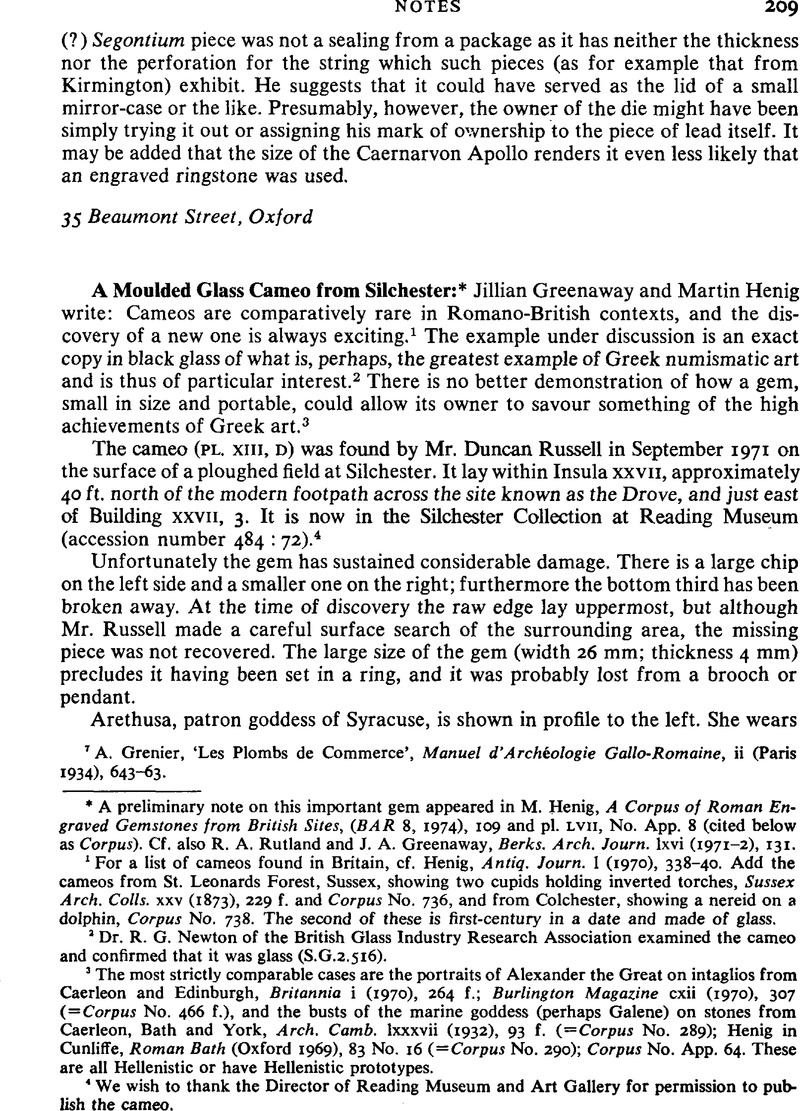No CrossRef data available.
Article contents
A Moulded Glass Cameo from Silchester*
Published online by Cambridge University Press: 09 November 2011
Abstract

- Type
- Notes
- Information
- Copyright
- Copyright © Jillian Greenaway and Martin Henig 1975. Exclusive Licence to Publish: The Society for the Promotion of Roman Studies
References
1 For a list of cameos found in Britain, cf. Henig, , Antiq. Journ. 1 (1970), 338–40CrossRefGoogle Scholar. Add the cameos from St. Leonards Forest, Sussex, showing two cupids holding inverted torches, Sussex Arch. Colls, xxv (1873), 229Google Scholar f. and Corpus No. 736, and from Colchester, showing a nereid on a dolphin, Corpus No. 738. The second of these is first-century in a date and made of glass.
2 Dr. R. G. Newton of the British Glass Industry Research Association examined the cameo and confirmed that it was glass (S.G.2.516).
3 The most strictly comparable cases are the portraits of Alexander the Great on intaglios from Caerleon and Edinburgh, Britannia i (1970), 264Google Scholar f.; Burlington Magazine cxii (1970), 307 (= Corpus No. 466 f.)MGoogle Scholar, and the busts of the marine goddess (perhaps Galene) on stones from Caerleon, Bath and York, Arch. Camb. lxxxvii (1932), 93Google Scholar f. (= Corpus No. 289); Henig in Cunliffe, , Roman Bath (Oxford 1969), 83 No. 16 (= Corpus No. 290); Corpus No. App. 64. These are all Hellenistic or have Hellenistic prototypes.Google Scholar
4 We wish to thank the Director of Reading Museum and Art Gallery for permission to publish the cameo.
5 Kraay, C. M., Greek Coins (London 1966), 291 and pl. xxxiv, Nos. 104–6.Google Scholar
6 ibid., 293 and pl. XLVIII, NO. 134 (Agathocles, 317–289 B.C.); 301 and pl. LXXII, NO. 206 (Siculo-Punic).
7 Richter, G. M. A., A Handbook of Greek Art (sixth edition, London 1969), 367, fig. 488. There is also an example in Liverpool Museum.Google Scholar
8 Furtwängler, A, Die Antiken Gemmen (Leipzig 1900), Vol i, pl. LXIV, NO. 58; ii, 294.Google Scholar
9 Richter, G. M. A., Engraved Gems of the Romans (London 1971), 157Google Scholar, No. 732. For style she cites a chalcedony scaraboid of the late fifth century B.C. cut by Sosias, cf. Richter, , Engraved Gems of the Greeks and the Etruscans (London 1968), 96, No. 319.Google Scholar
10 Walters, H. B., Catalogue of the Engraved Gems, Greek, Etruscan and Roman in the British Museum (London 1926), 361, No. 3851, fig. 88. Kraay, op. cit. (note 5), 291, colour pl. iv, No. III.Google Scholar
11 Vollenweider, M. L., Die Steinschneiderkunst und ihre Künstler im Spätrepublikanischer und Augusteischer Zeit (Baden Baden 1966), passim.Google Scholar
12 Schmidt, E., Antike Gemmen in Deutschen Sammlungen i part 3 (Munich 1972), 215, No. 3537. pl. CCCXXXIII.Google Scholar
13 Toynbee, J. M. C. and Richmond, I. A., Trans. Cumberland and Westmorland Arch. Soc.3 liii (1953), 40–8Google Scholar; Toynbee, J. M. C., Trans. Essex Arch. Soc. xxv part i (1955), 17–23Google Scholar; Harden, D. B., Antiq. Journ. lii (1972), 350–3 =Corpus Nos. 747 f.; App. 70.Google Scholar
14 Capis and Lituus, sard, Ac. No. 03008 (= Corpus No. 410); Marsyas, blue paste, Ac. No. 03022 (= Corpus No. 22).




